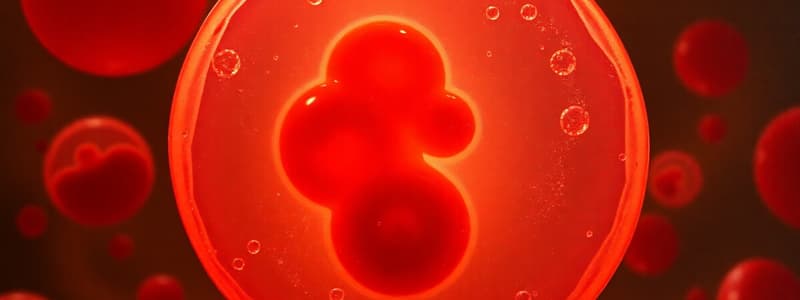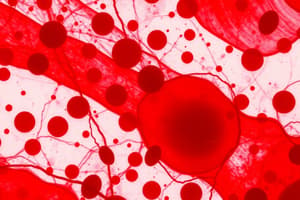Podcast
Questions and Answers
What is the score assigned to erythrocyte morphology when a severe increase in abnormal erythrocytes is observed in each microscopic field?
What is the score assigned to erythrocyte morphology when a severe increase in abnormal erythrocytes is observed in each microscopic field?
- 4+ (correct)
- 2+
- 3+
- 1+
In erythrocyte grading, what does a score of 2+ typically signify?
In erythrocyte grading, what does a score of 2+ typically signify?
- Normal appearance of erythrocytes
- Only a small population shows slight abnormalities
- Considerable presence of abnormal erythrocytes (correct)
- All erythrocytes are abnormal
At what hemoglobin concentration does the hemoglobin level in adults (male) typically fall?
At what hemoglobin concentration does the hemoglobin level in adults (male) typically fall?
- 12 to 14 g/dL
- 13 to 15 g/dL
- 10 to 12 g/dL
- 14 to 18 g/dL (correct)
How much oxygen can 1 gram of hemoglobin carry?
How much oxygen can 1 gram of hemoglobin carry?
What age group is indicated to have a hemoglobin reference range of 12 to 15 g/dL?
What age group is indicated to have a hemoglobin reference range of 12 to 15 g/dL?
Which statement accurately describes the synthesis of hemoglobin in red blood cells?
Which statement accurately describes the synthesis of hemoglobin in red blood cells?
Who identified hemoglobin as the respiratory protein in 1862?
Who identified hemoglobin as the respiratory protein in 1862?
What is the molecular weight of hemoglobin approximately?
What is the molecular weight of hemoglobin approximately?
Flashcards
Erythrocyte Morphology Grading
Erythrocyte Morphology Grading
A system for classifying the appearance of red blood cells (erythrocytes) under a microscope. It uses a numerical scale (0 to 4+) to describe how many and how significantly abnormal red blood cells are present.
Grading Scale 0
Grading Scale 0
Normal or slightly abnormal red blood cells; only a small amount of deviation from normal.
Grading Scale 1+
Grading Scale 1+
A slight increase in abnormal red blood cells.
Grading Scale 2+
Grading Scale 2+
Signup and view all the flashcards
Grading Scale 3+
Grading Scale 3+
Signup and view all the flashcards
Grading Scale 4+
Grading Scale 4+
Signup and view all the flashcards
Hemoglobin
Hemoglobin
Signup and view all the flashcards
Hemoglobin Reference Range (Children 8-13)
Hemoglobin Reference Range (Children 8-13)
Signup and view all the flashcards
Hemoglobin Reference Range (Adult Male)
Hemoglobin Reference Range (Adult Male)
Signup and view all the flashcards
Hemoglobin Reference Range (Adult Female)
Hemoglobin Reference Range (Adult Female)
Signup and view all the flashcards
Study Notes
Grading Erythrocyte Morphology
- Erythrocyte morphology grading uses a scale of 0 to 4+.
- 0: Normal appearance or slight variation in erythrocytes.
- 1+: Only a small population of erythrocytes displays slight abnormality.
- 2+: More than occasional numbers of abnormal erythrocytes are seen in a microscopic field; equivalent to moderately increased.
- 3+: Severe increase in abnormal erythrocytes in each microscopic field; equivalent to many.
- 4+: The most severe state of erythrocytic abnormality, with the abnormality prevalent throughout each microscopic field.
Hemoglobin
- Hemoglobin is the main component of red blood cells (approximately 95% of cytoplasmic content).
- Also known as respiratory pigment.
- Concentration of Hb in RBCs is approximately 34 g/dL.
- Molecular weight is approximately 64,000 Daltons.
- Felix Seyler identified the respiratory protein hemoglobin in 1862.
- About 65% of cytoplasmic hemoglobin is produced before the nucleus is extruded. The remaining 35% is synthesized in early reticulocytes.
- Single most common complex organic molecule in vertebrates.
- 1 gram of hemoglobin can carry 1.34 mL of O₂.
- 1 gram of hemoglobin can carry a constant 3.47 mg of iron.
Hemoglobin Reference Ranges
- Children (8 to 13 years): 12 to 15 g/dL (conventional) / 120 to 150 g/L (SI)
- Adult (male): 14 to 18 g/dL (conventional) / 140 to 180 g/L (SI)
- Adult (female): 12 to 15 g/dL (conventional) / 120 to 150 g/L (SI)
Studying That Suits You
Use AI to generate personalized quizzes and flashcards to suit your learning preferences.




